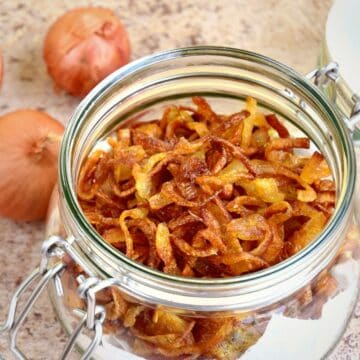Crispy fried shallots, or hom jiew in Thai, are magical. When done well, these sweet, crispy flakes seem to improve just about anything you put them on. It's a classic topping for many Thai dishes such as Hat Yai style fried chicken, son-in-law eggs and Thai chicken biryani.
But making them can be a bit tricky and many people end up with burnt, bitter, or oil-sogged shallots. So here's an in-depth guide to making perfect Thai-style fried shallots!

To Make or To Buy Fried Shallots
But why bother making them in the first place? Don't they sell these at Asian stores? Here are some things to consider.
Reasons to Buy Fried Shallots (and a trick to making them better)
- Fried shallots are not a snap to make, and while the frying is pretty quick, the bulk of the work is slicing them (usually with tears rolling down my face). And I'm always surprised at how little I end up with after all the shallots I prepped because they shrink after frying!
- Fried shallots are not "easy" (but also not "hard"). Not going to lie, there are a few things that can go wrong. First, uneven slicing will cause you problems when frying. Also, it takes experience to know the right time to remove them from the oil, and the right heat level specific to your stove and amount of shallots. So burning your first couple of batches is normal and should be considered part of the process.
My Secret for Improving Store Bought Fried Shallots
If you buy fried shallots, do this one thing: Refresh them in the oven. By the time you buy them at your local Asian store, it's probably been several months since they've been fried, and the packaging used are usually not air-tight. So they're not nearly as crispy as fresh, and can even taste stale.
Toasting them at a 300°F/150°C oven for just 5 minutes can make all the difference. They'll be crispier, slightly darker (and more flavourful) and will also shed a bit of oil as evidenced by your now-slightly-greasy baking sheet.
I shared this trick with J. Kenji Lopez-Alt for his NYT piece on fried shallots, and he tried toasting them in a dry skillet instead of baking and reported that it also works well. I prefer oven-toasting for a hands-free method, but it's a good option if you don't want to turn the oven on for this one thing.

Reasons to Make Your Own Fried Shallots
So why bother? If you have time, there are some good reasons:
- Fresh tastes better. While you may not nail your first batch, once you get it, there's nothing like freshly fried shallots that are sweet and aromatic.
- You can use fresh, high quality, healthier oil. I have seen fried shallots being made at commercial scale in Thailand, and the oil used is likely the cheapest on the market, used over and over again until very dark. When frying shallots at home, you can use the oil that makes you feel better about eating large quantities of them, because trust me, you will eat large quantities of them! I personally opt for avocado oil.
- The resulting shallot oil is aromatic and can be used to cook other things. Don't throw away the oil you used for the shallots! Use it to fry chicken, or simply to cook eggs or stir fries. There's good shallots flavour that has gone into that oil that shouldn't be wasted!
How to Make Crispy Fried Shallots
Here's a look at how to make perfectly crispy fried shallots that are not burned or soggy. Be sure to read these important recipe tips below as well!
Save this recipe!

- Slice shallots crosswise evenly to about 2 mm thickness (don't make them too thin) and sprinkle them with a pinch of salt and let sit for about 10 mins. The salt seasons them and also draws out moisture, making them crisp up faster.
- Spread them out on a paper-towel and press another piece on top and dry them off.
- You'll notice the shallots looking a little wilted; this is great!
- Add enough oil to keep all the shallots completely submerged, then add 1 test piece of shallot. Turn the heat on high and keep an eye for when the test shallot starts bubbling.

- Once the test shallot has a constant stream of bubbles, turn heat down to low, and add the rest of the shallots.
- Fry the shallots, stirring them frequently to avoid hot spots. In the first few minutes of frying there should be a constant stream of bubbles that's not too aggressive and not too weak; you might need to adjust the heat to medium low. Temperature doesn't have to be precise and I usually don't bother temping it, but if you want to, aim for 250-275°F, and stay under 300°F especially in the beginning when there are still a lot of bubbles so they don't brown prematurely.
- You're looking for the bubbles to be very weak if not gone almost completely (means they're crispy). And you want the shallots to be golden brown, but slightly lighter than the final result should be. Once they look like pic #7, get your skimmer ready as it's 30-60 seconds from being done.
- Scoop them out with a wire skimmer and drain on paper towel. Allow to cool completely before eating.
How to Avoid Burnt and Oily Fried Shallots
As mentioned, fried shallots can be a bit tricky. So here are some important tips to note before you start:
- Slice shallots as evenly as possible so that they will cook at the same time. You can slice them lengthwise or crosswise, depending on the look you prefer, but I feel it's easier to get an even thickness when slicing crosswise. A mandolin is recommended if knife skills are not your forte.
- Keep the heat low or medium low when frying. You need to give enough time for all the moisture in the shallots to evaporate, because that is how cripiness happens. If the heat is too high, they will brown faster than they can crisp. During the frying you want to see a constant stream of bubbles coming out, but not too aggressively.
- Wait for the bubbles to subside. Bubbling in oil is caused by moisture in the food evaporating as it's heated. So a lot of bubbles means a lot of moisture, which means food is not crispy.
When scooping out the shallots, the bubbles should look "tired" if not gone. If your heat is right, this should happen at the same time as the perfect golden brown. If they're dark before the bubbles subside, the heat is to high. - Take them out sooner than you think. They will darken a bit more after they come out of the oil, so take them out when they look "almost perfectly golden brown" and they'll get there as they drain.
- Don't let them linger in the oil without bubbling. Once the bubbles are almost gone, take them out promptly (and if they're not brown at this point, your heat is too low!). Letting them hang out in the oil while there are no bubbling action allows too much oil to seep into the shallots, causing oily, soggy shallots.
Storage Tips
It's very important to keep fried shallots in an airtight container otherwise they will absorb moisture from the air and turn soft.
Keeping them in the fridge doesn't harm them, and is advised if planning to keep them for a long time to prevent the oil from going rancid, and in humid climates. But come on, you will eat them much faster than that!
Troubleshooting Fried Shallots
This means your heat was too high. They needed more time to dry out all the moisture without getting browned.
You're probably too cautious with the heat! Turn it up a bit! I usually fry them on low heat, but depending on your particular stove and the amount of oil used, you might need to make this medium-low.
You likely let them linger in the oil for too long after they finished frying. Take them out promptly. Slicing them too thin can also cause this problem, so be sure not to go paper-thin with these. I have found about 2 mm to be ideal.
Uneven slicing of shallots is the main culprit. Try using a mandolin to help with this if you find it impossible to get even pieces.

Crispy Fried Shallots
Save this recipe!
Ingredients
- 3 large heads shallots, or as much as you want (see note)
- a pinch of salt
- Frying oil, as needed
Notes
FULL VIDEO TUTORIAL
All my recipes come with step-by-step video tutorials with extra tips not mentioned in the blog post, so make sure you watch the video to ensure success. If you enjoy them, consider subscribing to the YouTube Channel to not miss an episode. Thank you!
Subscribe to my YouTube ChannelInstructions
- Slice shallots evenly, crosswise, into 1/16 inch thick pieces and place them in a bowl. Add a pinch of salt and give it a toss to mix and let it sit for about 10 mins. The salt will draw out moisture from the shallots during this time.
- Spread the shallots out on a paper-towel-lined plate and press another piece of paper towel on top to dry off the drawn out moisture. This helps the shallots crisp up faster, the the salt also seasons them. Meanwhile prepare a plate or baking sheet lined with double layer of paper towel to drain the finished shallots.
- Add enough of the frying oil in a wok or a pot to keep the shallots completely submerged. Add one test piece of shallot into the oil, then turn the heat on high and keep an eye on it.
- Once the test shallot has a constant stream of bubbles coming out, turn the heat down to low and add the remaining shallots and stir them frequently as they fry, about 5-8 minutes.
- Once the shallots are golden, scoop them out with a mesh skimmer and drain them on the paper towel. They will darken more after the leave the oil, so take them out a little earlier.
- Allow them to cool completely, and use right away or store in an airtight container.










Robb says
Hi Pai - can you please include Celsius temperatures in your recipes for your Canadian readers? We are a metric country after all...(so is Thailand!) Thank you.
Benjamin Prusinski says
honestly just buy a deep fryer and call it a day.
Tami Mirshak says
What’s the best way to reheat the homemade crispy shallots if saving them for future use?
Megan says
I love fried shallots but often struggle to find them where I live. Would onion make a similar substitute?
Pailin Chongchitnant says
Red onion would be okay, try to go with the smallest one possible. But they're a lot more watery so make sure to slice them thinly and dry them out well.
Amber says
These came out perfect.
Same process for sliced garlic?
Not so much.
I did fry 6 large shallots so it took a bit of time.
Thank you for the tips.
dh says
Thanks for the tips! These turned out great. I had the heat up a little too high so they browned quickly but I was watching them.
K says
The time on this recipe is underestimated by at least 2x.
Sherry says
These turned out great. Your instructions were very, very good, and precise. Turned out first time through. Had a few bigger leftover pieces from using mandolin. Gave them a few extra minutes. Thank you.
Drew Cromer says
These came out really good, very hard to save them for my potato soup later.